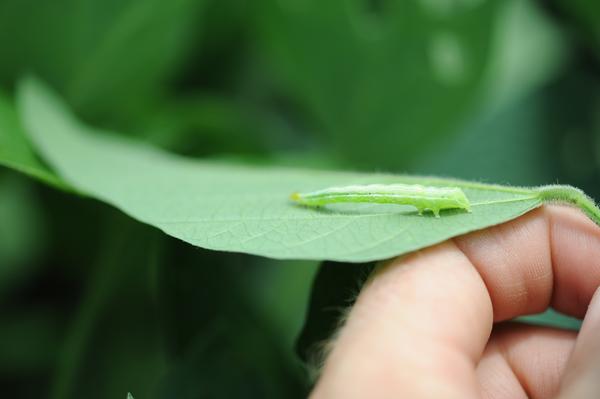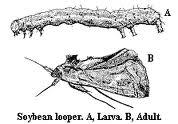Soybean looper, Chrysodeixis includens (Walker), Noctuidae, Lepidoptera
Biology
The defoliating soybean looper is a year-round resident of more southern areas, but it migrates into North Carolina each year. The immigration pattern is typically along the coast from south to north and spreading inland. Previous to 2010, coastal counties south of Cape Lookout had the highest likelihood of economic infestation, although in some years infestations spread above the Albemarle Sound and inland to I-95. Now, this insect migrates with more regularity to northeastern North Carolina, with fields often reaching the defoliation level.
The moth is a dark brown robust moth with a small silver-white figure eight spot on each forewing. Larvae are green with whitish lines along the length of the body and three pair of fleshy prolegs. The body of the larvae is tapered from the rear (largest) forward to the head. Often the true legs and head are black. Larvae crawl with a distinct looping motion and may rest in this pose. The caterpillar favors the lower plant canopy and leaf underside, but will feed over the entire plant as defoliation progresses.
Injury and Damage
This caterpillar is a voracious feeder and high-abundance populations can completely strip the foliage from fields; they do not feed on pods. Soybean looper moth populations peak in late August. Moths colonize soybean and cotton fields. High infestation is often associated with the removal of predators and parasites by insecticide use for corn earworm (bollworm) control. Also, research has shown that moths feeding on cotton nectaries develop and lay many more eggs, resulting in higher populations in the vicinity of cotton fields. Peak larval populations occur in September, mostly on later planted soybeans; as a result double crop soybeans are the most susceptible.
Economic Threshold
The threshold for defoliating insects is 30% defoliation throughout the plant canopy two weeks prior to blooming (R1) and 15% defoliation throughout the plant canopy two weeks prior to flowering (stage varies) until the pods have filled (R7-R8). Vegetative soybeans are tolerant of feeding and, as seedlings become larger and faster growing, this foliage loss is seldom of concern. Recent studies have demonstrated that soybeans can tolerate nearly 100% foliage loss during the early vegetative stages before yield loss is achieved.
However, defoliation during the reproductive growth stages can lead to significant yield loss, especially in soybeans with low yield potential. Often growers are tempted not to treat soybeans with a low yield potential. However, soybeans in yield-limiting situations have less ability to compensate and should be treated.
Insecticide Management
Recommended insecticides can be found in the North Carolina Agricultural Chemicals Manual.
Publication date: March 17, 2020
Reviewed/Revised: Dec. 18, 2024
N.C. Cooperative Extension prohibits discrimination and harassment regardless of age, color, disability, family and marital status, gender identity, national origin, political beliefs, race, religion, sex (including pregnancy), sexual orientation and veteran status.



